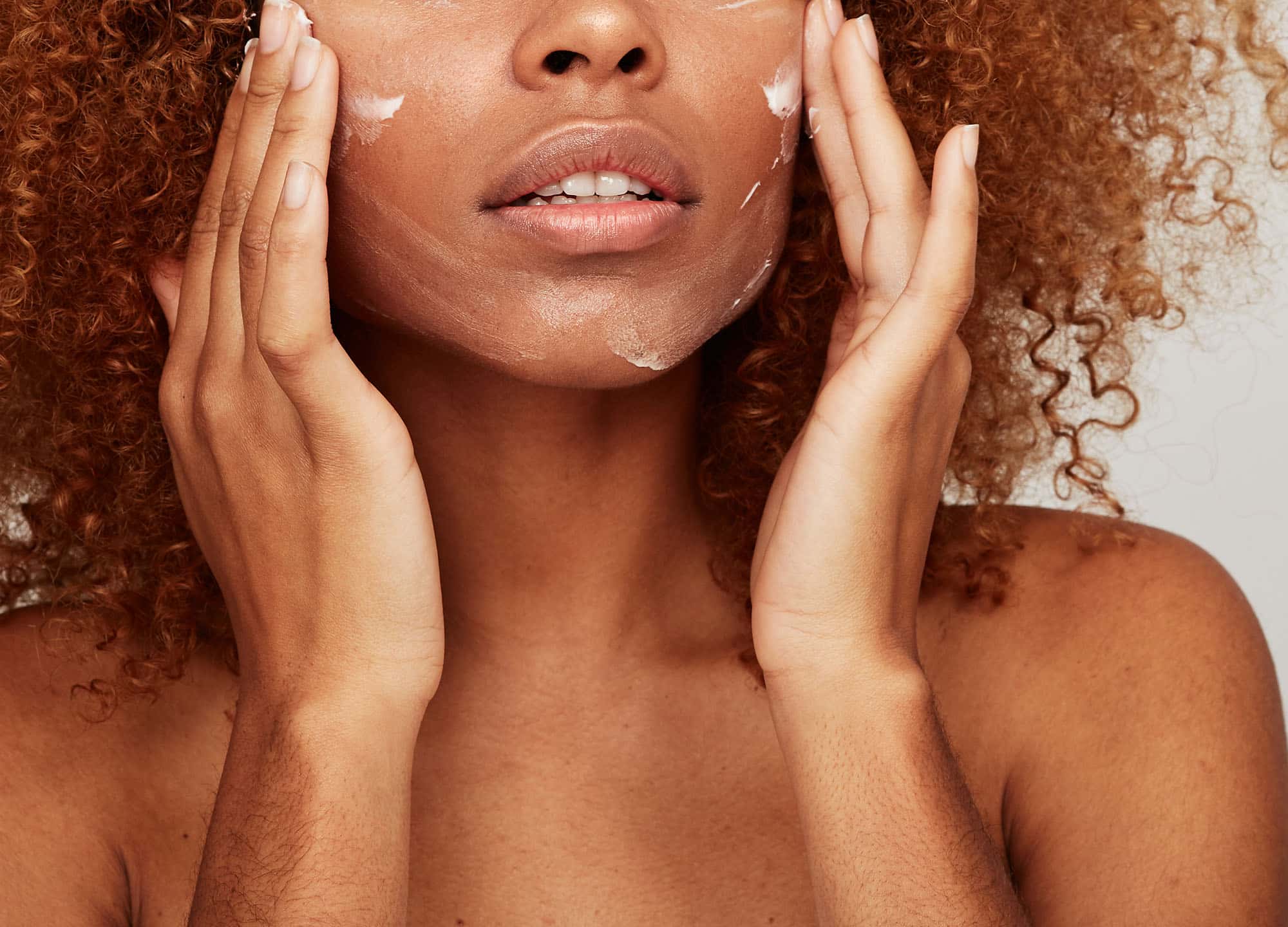Sure, we all have skin issues, but when it comes to caring for skin of color, there can be more to contend with than run-of-the-mill zits and wrinkles. Hyperpigmentation, for example—dark marks that give a mottled look—tends to be a constant battle for those who have more melanin, or pigment, in their skin.
Melanin is the largest influencer of an individual’s skin color: more melanin equals a darker complexion. “Skin tones are determined by the amount and organization of melanin within the melanosomes and keratinocytes,” explains Dr. Alexis Stephens, a board-certified dermatologist in Coral Springs, Florida. “Melanin is created by melanocytes in the skin. Melanocytes are programmed to produce certain types and amounts of melanin.”
Abundant melanin content affords skin a certain degree of inherent UV protection, making it less prone to sunburns and slower to develop wrinkles and other signs of sun damage—but it doesn’t impart all-out invincibility. “If people with dark skin tones smoke or vape, use tanning beds, and live an unhealthy lifestyle, they can wrinkle and age just as fast as their friends with lighter skin,” says Dr. Jeanine Downie, a board-certified dermatologist in Montclair, New Jersey.
Melanin-rich skin tones are more prone to experiencing hyperpigmentation when inflammation attacks the skin, explains Dr. Corey L. Hartman, a board-certified dermatologist in Homewood, Alabama. And inflammation can come in many forms. “UV rays, pollutants, burns, and irritation all overstimulate the enzyme tyrosinase, resulting in an excess of melanin to the skin surface,” says Dr. Stephens, which can present as irregular dark spots or patches.
“In my patients with acne, those with dark skin are often bothered as much or more by the dark spots that stick around after the pimples than by the pimples themselves,” explains Dr. Hadley King, a board-certified dermatologist in New York City.
All of which is to say, skin of color demands special care. Ahead, the top skin-care rules dermatologists share with their BIPOC patients.
Rule #1: go easy with active ingredients in skin-care products.
Be careful with ingredients that have the potential to cause irritation, as these can trigger postinflammatory hyperpigmentation (PIH), Dr. King says.
If you’re planning to use retinoids or benzoyl peroxide, it’s a good idea to consult with a dermatologist first, “because if used too quickly and at high concentrations, they can cause hyperpigmentation,” says Dr. Sandy Skotnicki, a board-certified dermatologist in Toronto.
Your derm can offer guidelines for safely incorporating these workhorse ingredients into your skin-care routine. Take retinoids—vitamin A creams that help with everything from acne to discoloration and wrinkles: Dr. Hartman advises his BIPOC patients to introduce these power players slowly by easing in with an over-the-counter retinol, applied only once or twice a week, at night, and always pairing them with a moisturizer, to minimize unnecessary inflammation. Likewise, since acne-fighting benzoyl peroxide “can cause irritant contact dermatitis for a disproportionate number of people with dark skin, it should be used as a cleanser, with short contact time, instead of a leave-on product.” CeraVe Acne Foaming Cream Cleanser ($12) combines benzoyl peroxide with ceramides, to offset potential irritation.
Gold-standard skin lightener hydroquinone (or HQ) should also be explored under the care of a derm, who can prescribe the ideal strength for your skin and explain how to use the bleaching ingredient properly. According to Dr. Stephens, the percentage of HQ found in drugstore products is generally “too low to be effective but high enough to cause irritation and worsen pigmentation.”
“Hydroquinone must be monitored,” echoes Dr. Hartman. “It’s so potent that it can cause halo pigmentation, or an area of skin that is too light around the original dark spot—which makes for a mottled and unnatural skin tone.”
To sidestep this complication, doctors will sometimes reserve HQ as a last resort and, instead, start patients on gentler skin brighteners, like azelaic acid, tranexamic acid, or cysteamine, which can achieve “similar and sometimes superior” results, Dr. Hartman says.
Rule #2: treat hyperpigmentation carefully, should it arise.
Irksome ingredients aren’t the only instigators of hyperpigmentation—anything that the skin registers as an insult or injury can spur pigment cells to crank out more melanin. This means skin picking and popping pimples are especially big no-nos for those with skin of color.
For minor mottling, Austin aesthetician Renee Rouleau suggests using a mild exfoliating acid cleanser, once a week, to loosen up discolored cells from the skin’s surface. (Try Senté Exfoliating Cleanser, $29, which has glycolic and phytic acids.) Then, once or twice a week, lightly circle a gentle scrub—with nonplastic, rounded beads—over skin, to physically lift off damaged cells that have been uprooted by your cleanser.
For more severe or stubborn PIH, talk to your derm about adding the aforementioned lighteners to your skin-care lineup. And don’t forget: UV rays can exacerbate discoloration across skin tones, so sunscreen with an SPF higher than 30 is essential when battling hyperpigmentation. Look for formulas with added brighteners, like vitamin C and niacinamide, to help even things out. Obagi Sun Shield Matte Broad Spectrum SPF 50 ($53) is a derm favorite.
Rule #3: wear sunscreen every day, to keep skin healthy, youthful, and even-toned.
Since the melanin in darker skin tones does not offer complete protection from the sun’s cancer-causing rays, sunscreen is still a daily must for those with skin of color. According to Skincancer.org, Black patients are three times more likely to be diagnosed with melanoma at a later stage than non-Hispanic white patients. Moreover, “even if your skin is darker, you can still absolutely get a sunburn,” says Dr. Howard Murad, a board-certified dermatologist in Los Angeles. “When you burn, it affects your whole body. So although it might not be as obvious to the eye, the person will still suffer from headaches, nausea, and inflammation, depending on the scale of the burn.”
Historically, sunscreens would turn dark skin types ghostly, making them the last thing anyone wanted to apply. This white film was commonly associated with mineral ingredients, such as titanium dioxide and zinc oxide, says Dr. Murad. But that’s really no longer the case, thanks to improvements in mineral sunscreen technology. “Physical blockers such as zinc oxide and titanium dioxide are now smaller and less visible to the eye,” notes Dr. Audrey Kunin, a board-certified dermatologist in Kansas City, Missouri. And sunscreens that rely on chemical filters, like Black Girl Sunscreen SPF 30 ($18.99), “are even less likely to be seen.”
A new wave of tinted sunscreens have also made sun protection more palatable for those with dark complexions. The iron oxides in tinted products not only boost blendability but add a layer of defense against visible light (emitted by the sun and devices), which has been shown to promote and worsen hyperpigmentation conditions—melasma included—in skin of color. Two go-tos: Alastin HydraTint Pro Mineral SPF 36 ($55) and SkinCeuticals Physical Fusion UV Defense SPF 50 ($34).
Rule #4: moisturize head to toe, to avoid ashiness.
Dry skin happens to everyone, but when it happens to skin of color, it’s very noticeable due to the dull, white cast it can leave behind. Ashiness can be brought on by your environment (cold weather and moisture-sapping indoor heat); long, hot showers or baths; and soaps, lotions, and detergents with harsh chemicals.
“Black skin is especially susceptible to dryness due to a low ceramide content, compared to other racial groups, as well as an increased rate of transepidermal water loss. It also has a thicker, more compact stratum corneum that desquamates, or sheds, giving the appearance of ashiness, especially in the background of more darker pigmentation, compared to Caucasian skin,” notes Dr. Adeline Kikam, a board-certified dermatologist in Houston, Texas.
And whenever skin is dry, Dr. Hartman adds, “it’s prone to irritation, redness, and inflammation”—and, consequently, hyperpigmentation.
To avoid it, be sure to “use gentle cleansers that won’t strip the skin of its natural oils and moisturize regularly,” says Dr. King. Synthetic-detergent cleansers, such as Dove Radiant Skin Face Cleanser ($6) and Eucerin Advanced Cleansing Body & Face Cleanser ($9), are a mild alternative to traditional soaps, which commonly deplete the skin’s moisture barrier.
After cleansing, smooth on a moisturizing lotion or cream, like La Roche Posay Lipikar Balm AP+ ($20), while skin is still slightly damp, to boost hydration. “Ideally, moisturizers should contain a combination of water-binding humectants [like glycerin and hyaluronic acid], to hydrate, emollients, to support the skin barrier, and occlusives, to lock in the moisture,” says Dr. King.











